The Pharm Exec Pipeline Report 2007
You couldn't call it a gusher, but the pipeline has still has some life in it, and important new therapies are working their way toward approval. Have we turned the corner? Judge for yourself, with the help of this guide to 61 of the best new products in development.
Sobering fact: Pharma's drug pipeline is producing half the number of truly new medications it turned out a decade ago. 2008 is likely to see between 24 and 29 new molecular entities launch worldwide, according to IMS Health. Compare that with 1997, when IMS counted 52 new compounds for sale. Output has dwindled steadily for 10 years. There is no uptick in sight.
"Every piece of data suggests that research is not a core competency of Big Pharma," says Barbara Ryan, a managing director and pharmaceutical analyst at Deutsche Bank. "Something will have to change. The big companies may have to learn to outsource more research and figure out how to maintain access to it."
As discouraging as the numbers look, some great products are moving through clinical trials. From fresh insights into the beta-amyloid pathway, which offer the tantalizing prospect of preventing Alzheimer's disease, to a host of new antibacterials set to battle that scourge of hospitals, MRSA, the industry is tackling some of the nation's major health challenges. Here's a look at 61 new drugs that our experts from Wall Street to university teaching hospitals find most exciting.
You Must Remember This . . .
Alzheimer's: Prevention and Management
Upcoming Alzheimer's drugs seek to slow the course of the disease by intervening in the beta-amyloid pathway, focusing on a toxic soluble form of amyloid that later congeals into amyloid plaque, according to Jeffrey Cummings, MD, director of the Alzheimer's Disease Center at UCLA. The plaque itself, largely benign, is an after-effect of the damaging process.

Flurizan, a gamma secretase modulator, interferes with the manufacture of "amyloid precursor protein," the parent protein of amyloid. With Flurizan, gamma secretase produces less of the most-toxic variety of soluble amyloid and more of a less-toxic sort, Cummings explains. Flurizan's efficacy data is expected in early 2008.
Bapineuzumab, a humanized monoclonal antibody, is infused intravenously to remove plaque—as well as the toxic intermediate—from the brain, Cummings said. PBT2, a chelator or metal-protein attenuating compound, is currently in a Phase II trial in Sweden. According to Cummings, the drug is designed to inhibit the aggregation of amyloid before it becomes toxic. Researchers theorize that accumulation of metals in the brain converts beta-amyloid into an enzyme that catalyzes production of hydrogen peroxide and damages brain cells.
The hope, Cummings says, is that one of these drugs makes it possible to intervene early in the onset of the disease, retard the development of soluble amyloid, and thereby prevent the memory loss and dementia. The recent failure of Neurochem's Alzhemed to show drug–placebo differences in a Phase III trial was a disappointment, Cummings admits, but not a reason to give up on the beta-amyloid pathway. The company is continuing to evaluate the treatment.
Dimebon, a symptomatic agent in the same family as Forest's Namenda (memantine), is a cholinesterase inhibitor and NMDA receptor antagonist that inhibits mitochondrial pore formation. It raised hopes by exceeding goals in a Phase II trial in Russia. "At 12 months, the difference between drug and placebo on some measures was larger than at six months," Cummings said. "That's what one would expect with a disease-modifying compound."
Statin Supercharger
Cholesterol: 50 Percent More Power
Mipomersen adds 50 percent to the power of statins. "With this drug, up to three-quarters of patients achieved LDL levels below 70 milligrams per deciliter," said Donny Wong, senior analyst at Decision Resources. "That's the lowest target for patients at the highest risk of heart attack." The weekly injectable will first target familial hypercholesterolemia, which causes very high levels of LDL cholesterol in very young people. But Wong says the drug is likely to be appropriate for the patient with an LDL cholesterol level of 200 who isn't responsive to a statin.

Butt Out
Smoking: Taking the Pleasure Out of Tobacco
Despite the early successes of Chantix (varenicline), a partial nicotinic receptor agonist that Pfizer launched last year, the smoking-withdrawal field remains wide open. "We see a number of treatment approaches but no standard of care," said David Smith, MD, an addiction specialist and past president of the American Society of Addiction Medicine.
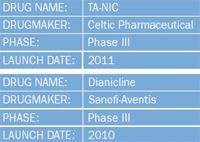
Celtic Pharma's TA-NIC is a vaccine designed to produce antibodies to nicotine. The antibodies bind to nicotine in the bloodstream, reducing its rate of entry into the brain—and thus the positive reinforcement associated with smoking.
Dianicline, like Chantix, acts on the alpha4-beta2 nicotinic acetylcholine receptor. It allows nicotine to enter the brain, but binds preferentially to the receptors that produce pleasurable effects.
"These new approaches all help," Smith said. "But we have not seen the treatment that will reduce withdrawal and craving for every smoker."
Staph Meeting
Antibiotics: Battling MRSA
A new wave of antibiotics aims to take on two tough challenges: fighting hospital-acquired MRSA (methicillin-resistant Staphylococcus aureus) and winning patient share from vancomycin, the cheap, 50-year-old drug administered to more than half of hospitalized US patients with MRSA.

One of the biggest problems for Pfizer's dalbavancin may be avoiding direct competition with Zyvox (linezolid), the drug giant's popular IV antibiotic—a preferred pneumonia treatment, and the only product in the space with a step-down therapy that lets patients take their hospital antibiotic orally at home. Dalbavancin, designed as the first once-weekly injectable antibiotic, nearly guarantees patient compliance. People leave the hospital and do nothing but return for a second dose seven days later.
Ceftobiprole medocaril, a joint project by Basilea Pharmaceutica and subsidiaries of Johnson & Johnson, may be the most eagerly anticipated drug in the space. Formulated as a prodrug to increase its water solubility, the new compound promises to be the first cephalosporin to show activity against MRSA.
"The drug rides on a history of positivity," says Danielle Drayton, an analyst at Decision Resources. "Doctors love cephalosporins. To have a cephalosporin active against MRSA is huge. This is a drug that will have leading sales for MRSA treatment in the future." Drayton notes that ceftobiprole not only kills gram-positive bacteria, such as MRSA, but gram-negative organisms as well.
Takeda and Forest Labs are working on ceftaroline fosamil, a cephalosporin that should hit the market in late 2010. Also delivered as a prodrug for solubility reasons, ceftaroline fosamil promises most of the advantages of J&J's compound. Even so, J&J and Pfizer will have a strong marketing advantage in hospitals, since they can bundle two or three antibiotics in a single-price package, Drayton says.
Oritavancin has bounced from company to company. Lilly originated development in 1995 and licensed it to InterMune in 2001. Targanta Therapeutics acquired world rights in 2005. The long half-life of the compound may allow once-daily dosing, but it otherwise has a profile similar to vancomycin. "It's an incremental improvement over the current standard of care, at best," said Kevin Richard, a managing director at investment banking firm Leerink Swann.
Telavancin has two mechanisms of action. "Having a dual mechanism of action theoretically has a potential to keep resistance development low," Drayton says. However, she notes that vancomycin has retained almost miraculously low resistance against MRSA. Only 10 patients in 50 years have been reported with complete vancomycin resistance, although "intermediate resistance" has become increasingly common. Telavancin set out to prove superiority to vancomycin in clinical trials but achieved only non-inferiority, according to Drayton.
All these drugs can be expected to move through clinical trials again to determine efficacy against "community MRSA," which is genetically different from the hospital-acquired strain.
A Pain in the Leg
Peripheral Arterial Disease: Growing Blood Vessels
People with peripheral arterial disease endure intense pain. Frequently, they can't walk. In severe cases, they die from a huge clot in the leg that stops blood flow.
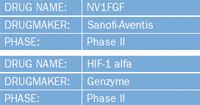
Two new drugs for PAD are angiogenic gene therapies that build blood vessels in ischemic limbs. "NV1FGF is a plasmin-based gene expression vector," explains Donny Wong, a senior analyst at Decision Resources. "Basically it's DNA that you inject into the patient's leg to cause the expression of FGF1, which is Fibroblast Growth Factor."
Genzyme has a similar gene therapy for this vascular disease: HIF-1 alfa, which stands for hypoxia inducible factor-1-alpha.
"It's kind of a high-risk therapy," Wong says, noting that the drugs could feed an undetected tumor. "But if it's successful, these drugs are potentially billion-dollar earners."
Acomplia Forever?
Obesity: Losers Are Gainers
Rimonabant (Zimulti), which remains better known as Acomplia, has fallen from an odds-on blockbuster four years ago to the Great American Longshot. Sanofi-Aventis, undaunted by FDA’s safety concerns, may submit an NDA for diabetes indications as early as next year. Both Merck (taranabant) and Pfizer (CP 945598) remain committed to similar cannabinoid receptor antagonists, despite fears that their products may also produce depression and suicidal ideation, the side effects that hamstrung rimonabant.
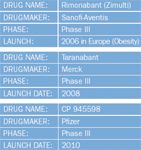
The expected payoff is huge if FDA smiles on one of these compounds. Lehman Brothers estimates $3 billion in peak sales for Pfizer's obesity candidate in 2018—but gives it only a 20 percent chance of success. Merck, which aims to file an NDA for taranabant in 2008, can expect a similar risk-to-payoff ratio.
"I'm impressed by rimonabant as a drug that can lower weight by 4 to 5 percent below placebo," said Dr. Robert Eckel, professor of medicine, division of endocrinology, metabolism and diabetes, at the University of Colorado. "But if you think about it conceptually, a drug that modifies endorphins and opiate neurochemistry may, in fact, modify mood. I thought from the beginning that it might be a limitation, and I'm sorry to see that it is."
The Uncommon Cold
RSV: Attacking a Baby Killer
Respiratory syncytial virus (RSV) is the most common cause of bronchiolitis and pneumonia among children under 12 months. As few as one in 200 of those infected require hospitalization, but these cases account for 50,000 to 80,000 hospitalizations in the United States, according to the Centers for Disease Control and Prevention. RSV, fatal in some cases, causes repeated cold-like infections later in life and leads to severe lower-respiratory-tract disease, especially among the elderly or among those with compromised cardiac, pulmonary, or immune systems.
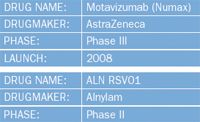
Motavizumab, developed by MedImmune before the company was sold to AstraZeneca earlier this year, is a monoclonal antibody aimed at preventing RSV infection in full-term infants. "It's significant breakthrough," says Murray Aitken, an analyst at IMS Health. In Phase II and III trials, motavizumab has proved more efficacious than its primary rival, palivizumab, a similar MedImmune drug.
ALN RSV01 is a small interfering RNA (siRNA) drug delivered to the RSV infection in the lungs, where it silences a key viral gene. Clinical studies on adult volunteers delivered the therapy using intranasal spray or a neubulized formula appropriate for hospitalized infants.
Still Waiting to Inhale?
Diabetes: After Exubera
Three inhaled-insulin therapies remain standing after Pfizer's spectacular failure with Exubera. Only one, MannKind's technosphere product, has a realistic chance of competing as a diabetes treatment. MannKind's powdered insulin is not just convenient but it reaches the bloodstream faster than subcutaneously injected insulin.
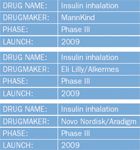
"MannKind's product has a much more rapid-acting profile," said Jay Skyler, MD professor, division of endocrinology, diabetes, and metabolism, University of Miami Miller School of Medicine. "The Lilly and Novo products, just like Exubera, have an onset similar to the existing rapid-acting insulin analogues. No question that both the Novo and Lilly delivery systems have advantages over Pfizer's."
But the market has changed. "Injections are no longer as difficult as Pfizer projected" when the Nektar/Pfizer project began in 1996, added Skyler. According to Barbara Ryan, pharmaceutical analyst at Deutsche Bank, the injection pen beat inhaled insulin to the convenience market. "Longer term, unless you show some real clinical benefit beyond convenience," she said, "inhaled insulin will have a pretty difficult mountain to climb."
"Back on the Horse"
HDL Cholesterol: Torcetrapib Redux
Pfizer spent $1 billion to develop the CTEP inhibitor torcetrapib, a drug that aimed to raise levels of HDL ("good") cholesterol, then pulled the plug when studies showed that patients on a combination of Lipitor and torcetrapib were 25 percent more likely to die than patients on Lipitor alone. Now Roche and Merck are hoping that their own CETP inhibitors—drugs that block cholesterol ester transfer proteins and prevent the transformation of good HDL into bad LDL cholesterol—will not have the Pfizer drug's fatal flaw.

"The question that remains is whether it was a class effect or an effect specific to Pfizer's particular compound," said Donny Wong, a senior analyst at Decision Resources. "Merck claims that its drug [anacetrapib] doesn't raise blood pressure. And Roche claims that its drug [dalcetrapib] operates by a different mechanism of action from torcetrapib."
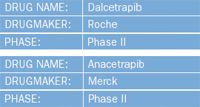
After seeing torcetrapib's final data at the American Heart Association in November, Steven Nissen, MD, head of cardiology at the Cleveland Clinic in Ohio, concluded that HDL drugs are viable. "We can get back on the horse and try again," he told Bloomberg News. Merck and Roche are expected to announce this month whether their programs will go forward.
Beyond Interferon
Hepatitis C: Targeting Nonresponders
Compared with AIDS, hepatitis C is a "raging, less-known epidemic," says John Lebbos, MD, director of infectious diseases at Decision Resources. Interferon is the standard of care, but it works only about half the time. Drugmakers face a patient population with advanced cases, many undiagnosed, most with progressive liver damage, including fibrosis and cirrhosis.
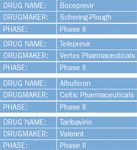
The most hotly anticipated new drugs are boceprevir and teleprevir, both protease inhibitors, which have yet to be differentiated by clinical data. "Physicians told us that what's most important is an increase in efficacy," says Lebbos. The first to market with a more effective drug will have first shot at the huge patient population of "nonresponders." In the long term, the differentiating factors will be sustained virological response (SVR) and resistance profile.
"It's not like HIV, where you might have an inherently resistant strain," Lebbos says. "The drugs are helping the body mount an immune response. If one protease inhibitor is less prone to resistant response, we will probably just see a higher proportion of patients responsive to it."
Albuferon is an incremental improvement over pegylated interferon. It may not be superior except for dosing and related quality-of-life issues, but that may be enough to win market share. "We see Albuferon exceeding $2 billion in sales if it pans out," Lebbos says.
Interferon is often administered with ribavirin, a somewhat nonspecific antiviral. Taribavirin is a ribavirin analogue, a new formulation to minimize side effects like anemia. The question there is efficacy: Noninferiority and safety may not be enough for an adjuntive therapy in the Hep C market, where physicians are keen on efficacy improvements.
No Reinforcement
Cocaine: Blocked From the Brain
TA-CD is a vaccine designed to elicit production of antibodies to bind cocaine molecules in the blood stream and prevent them from entering the brain. This eliminates the drug's psychoactive effect. By blunting the pleasurable experience associated with cocaine, TA-CD can reinforce a treatment plan including substance-abuse counseling and related therapy. "Vaccines are a very rational approach for a substance with the profound reinforcing effects of cocaine," says Barbara Mason, professor, Committee on the Neurobiology of Addictive Disorders at Scripps Research Institute in La Jolla, CA. "But you have to have patients who are willing to take the drug. I'm thinking niche drug instead of wide-scale treatment."

Head to Head
Migraine: As Effective as Rizatriptan
Migraine afflicts almost one in five women and more than one in 20 men. Roughly two of three patients who suffer these debilitating headaches experience relief from Maxalt (rizatriptan), the current standard, which Merck launched in 2003.

In a head-to-head Phase IIb comparison MK 0974 was as effective as rizatriptan in relieving pain two hours after administration, according to Alan Rapoport, MD, clinical professor of neurology at UCLA Medical School and founder/director-emeritus of the New England Center for Headache in Stamford, CT. Among 420 patients, 68.1 percent of those taking 300-milligram doses of MK 0974 reported no pain after two hours, compared with 69.5 percent of patients taking rizatriptan. At the 24-hour mark, 39.6 percent of MK 0974 patients were pain free compared with 18.4 percent of rizatriptan patients. Phase III trial results are expected within a year, according to Rapoport.
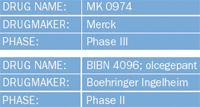
Both MK 0974 and BIBN 4096 are calcitonin gene-related peptide (CGRP) receptor antagonists. (Rizatriptan is a selective agonist at serotonin 1D and serotonin 1B receptors.) BIBN 4096 proved efficacious and safe in a 2004 Phase II clinical trial and was celebrated as a breakthrough in the New England Journal of Medicine. But it has not moved forward in the clinic for three years, and it is an injectable—not desirable in a headache drug. MK 0974 is a tablet taken by mouth.
Rapoport and other clinicians hope that many patients who do not respond to triptans will get relief from CGRP antagonists. "MK 0974 is clearly effective against migraines," Rapoport said. "But there is still a lot we don't know about how exactly it works."
Making Cocktails
HIV: Mix-and-Match Therapies
No new HIV drug is conceived as a monotherapy. As new molecules and mechanisms, emerge, the first question is how they fit into existing therapies."HIV patients have very different needs when it comes to viral suppression, side effects, and so on," said Sylvia Eash, an analyst at Decision Resources. "New drugs are tested in treatment-experienced and treatment-naïve patients—and always in combination with other drugs."
Bevirimat is the first drug to inhibit the growth of an HIV particle by preventing a precursor protein from maturing into capsid, one of the key proteins of the mature virus. Panacos has had some difficulties in creating a capsule version of the drug, which has been tested mostly in liquid form.

The hype surrounding Pfizer's first-in-class entry inhibitor, the CCR5 antagonist maraviroc (Selzentry), created an air of disappointment when the drug did well but was not a spectacular success. Schering-Plough's new CCR5 antagonist, vicriviroc, will have to differentiate itself from the Pfizer rival to break into the same combination therapies. But the greatest obstacle for both drugs is a class problem. Patients must undergo what Eash calls a "cumbersome" test to see if they are infected with the CCR5 or CXCR4 virus, a variant against which CCR5s are ineffective. The battle for share of the CCR5 market may come down to dosing and convenience. InCyte's INCB9471 has a long half-life and a different binding site on the chemokine receptor CCR5 and can be expected to compete for CCR5 market share. PRO 140, a monoclonal antibody further back up the pipeline with Progenics, attacks the CCR5 receptor with yet another mechanism.
HIV is a clever and persistent virus that learns to beat back many therapies. Manufacturers keep pipelines stocked with new protease and integrase inhibitors as back-up therapies. Increasingly, according to Eash, they aim new drugs at expected resistance problems. Merck, for example, has begun to test drugs such as MK-2048 and others in its preclinical integrase inhibitor research program against viral strains resistant to raltegravir, a recently approved Merck integrase inhibitor expected to launch next year.
Fighting Side Effects
Weight Loss: Fen Phen Redux
Old pharma hands will be forgiven if they see lorcaserin as a new, safer version of the "fen" in Fen Phen. The serotonin inhibitor fenfluramine (like its replacement, dexfenfluramine) was famously taken off the market when it turned out it reacted with serotonin 2B receptors on heart valves, resulting in damage to the valves. Arena hopes that lorcaserin, a serotonin 2C receptor agonist, is specific for receptors in the brain.

"They want to see if they can get a good weight-loss effect without side effects or heart-valve lesions," says F. Xavier Pi-Sunyer, MD, professor of medicine at Columbia University College of Physicians and Surgeons and director of the New York Obesity Center. In an early 12-week trial, the lorcaserin patients lost an average of eight pounds, according to F. Xavier Pi-Sunyer, MD, professor of medicine at Columbia University College of Physicians and Surgeons and director of the New York Obesity Center, who expressed optimism about the efficacy and safety of the drug.
Qnexa resurrects the "phen" in Fen Phen. The drug combines phentermine with topiramate, an anticonvulsant that Johnson & Johnson markets as Topamax. Topiramate was proven to cause weight loss in clinical trials for obesity, but patients disliked it. "People got peripheral neuropathy in their hands and feet—even painful neuropathy," said Robert Eckel, MD, professor of medicine, division of endocrinology, metabolism, and diabetes, at the University of Colorado.
One physician, who declined to be named, speculated that by adding phentermine and sharply reducing dosages, developers could eliminate the topiramate side effects. Pi-Sunyer, however, who said trials patients lost 25 pounds in 24 weeks, expressed concern about other side effects, including memory loss.
The basic strategy of combining antidepressants with CNS drugs does not always go smoothly, Pi-Sunyer says. Contrave, which combines buproprion, an antidepressant, with naltrexone, an opioid receptor antagonist, had no adverse effects besides fatigue and insomnia. However, patients lost less than eight pounds in 24 weeks. Excalia, a combination of bupropion and zonisamide, an antiepileptic, produced more than 9 percent weight loss. But 37 percent of patients dropped out of the trial, complaining of nausea and other side effects.
Reducing Clotting
Antiplatelets: One's Powerful, One's Reversible
Data from the Phase III clinical trial of prasugrel, released at the American Heart Association (AHA) meetings in November, suggest that Lilly's new antiplatelet therapy is much more effective at reducing harmful blood clots for patients with acute coronary syndrome (ACS) than clopidogrel (Plavix), one of BMS's biggest drugs. But the new drug's increased efficacy comes at a price: It causes more bleeding than clopidogrel, and it probably cannot be used as widely.

"Coming out of the AHA meeting, our feeling is that prasugrel is clearly an approvable drug because of the dramatic efficacy," said Barbara Ryan, pharmaceutical analyst at Deutsche Bank. "The question is: What patient are you going to use this drug in? Our view would be that doctors are going to move cautiously. The ACS population is a market of about $1.5 billion. If you eliminate the elderly and people with compromised renal systems or who have already had a stroke, you get a market of $750 million. And Lilly won't get all of that, so you really have a drug worth hundreds of millions."
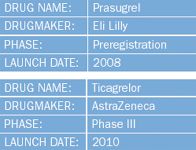
Competition for prasugrel lurks just up the pipeline. Ticagrelor has one big potential advantage over prasugrel: A physician can turn off its effects. "Ticagrelor is a reversible agent that you can stop very quickly," says Jeremy Goldman, MD, an analyst at Decision Resources. "If you can't stop the drug, it's difficult to go for coronary bypass surgery because your patient may bleed, and that could be fatal."
Ticagrelor is going head-to-head against clopidogrel in worldwide Phase III trials enrolling 18,000 patients, according to the Wolters Kluwer R&D Insight database. A Lehman Brother's analysis projects worldwide ticagrelor sales of $1.5 billion by 2017.
After Fosamax
Osteoporosis: Keep Your Eye on Anabolics
Merck’s osteoporosis blockbuster Fosamax (alendronate) loses patent protection in February. FDA has granted tentative approvals to IVAX, Barr, and Teva to market generic versions of the mainstay bisphosphonate therapy then. And at about the same time a major new drug will launch. "That's enough to make the osteoporosis market a pretty interesting one to watch next year," says Murray Aitken, analyst at IMS Health.

A lot of the interest will be seeing what happens to the new launch, bazedoxefine, Wyeth and Ligand's jointly developed drug for postmenopausal osteoporosis, which launches at about the same time. Bazedoxifene is a selective estrogen receptor modulator (SERM), like Lilly's Evista (raloxifene). That could create problems for the new drug. "Raloxifene has not been proven to reduce the risk of hip fractures the way bisphosphonates have," said Hosam Kamel, MD, professor of medicine at the University of Arkansas Medical School, in Little Rock.
Other new approaches to osteoporosis wait in the wings. Several, like bisphosphonates, aim to decrease the level of bone breakdown, or resorption. Amgen's denosumab, for example, a monoclonal antibody aimed primarily at bone cancer and multiple myeloma, is in Phase III clinical trials for osteoporosis too. The drug inhibits the differentiation of osteoclasts, which resorb bone. Odanacatib inhibits cathepsin K, an enzyme produced by osteoclasts.
"Bone formation, not reduced resorption, is the holy grail," said Kevin Richard, an analyst at Leerink Swann. "You have to keep your eye on the anabolic therapies now, as opposed to the antiresorptives, like the bisphosphonates."
Ronacaleret is one of several new therapies aimed at increasing levels of parathyroid hormone, which promotes anabolic bone formation. The small molecule by NPS Pharmaceuticals/GlaxoSmithKline creates transient increases of PTH by blocking calcium-sensing receptors on the surface of parathyroid cells.
Ostabolin-C, under development by Zelos in subcutaneous-injectible and oral versions, is a PTH agonist that stimulates bone formation. The drug molecule is a chain of 31 amino acids that resembles the N-terminal region of the parathyroid hormone. Ostabolin will compete directly with Forteo (teripatide)—a similar 34-amino-acid drug, marketed by Lilly—which is widely used despite a black-box warning for bone cancer.
Restoring Muscle Mass
SARMs: Testosterone's Benefits, Without the Negatives
Selective androgen receptor modulators, which bond selectively to testosterone receptors, give new hope to victims of cachexia, or muscle wasting. People who lose muscle mass in bouts with cancer or AIDS, as well as burn victims and patients who wither after surgery, can reap most of the anabolic benefits of testosterone from SARMs without suffering the androgenic side effects.

"SARMs make it possible to produce some hormone effects and avoid others," said Hosam Kamel, MD, professor of medicine at the University of Arkansas Medical School, in Little Rock. "In other words, male patients build muscle tissue without prostate enlargement, while women experience no secondary sexual characteristics, such as hair growth."
In the past six weeks, both GTx and Pharmacopeia have made SARM-related deals with Big Pharma. Pharmacopeia licensed SARM compounds from Bristol-Myers Squibb in an unusual barter deal. The smaller company provides three years of chemistry services in lieu of an up-front payment, but pays cash milestones thereafter. Merck made a $40 million initial investment in GTx's SARM research program, which contains as many as 250 compounds, according to the Wolters Kluwers R&D Insight database. Merck will also buy GTx common stock at a 40 percent premium and may make milestone payments of more than $400 million for successful compounds, according to news reports.
Cancer: Five New Approaches
Ipilimumab/Ticilimumab
These monoclonal antibodies both target CTL4-A, a receptor found on the surface of T-cells that serves as a "brake" on T-cell activity. The drugs, which are being developed first for malignant melanoma, aim to block CTL4-A and release additional T-cells to fight cancer. Both were licensed from Medarex, which in turn licensed the technology from the University of California–Berkeley.

Malignant melanoma is among the fastest-growing cancer markets in the developing world, but it remains relatively small. Lehman Brothers estimates peak world sales of the Pfizer drug at $500 million in 2015, while the BMS compound is expected to double that worldwide in the same year, according to the Wolters Kluwer R&D Insight database.
Zactima
The v-and-e at the beginning of "vandetanib" refers to the drug's rare property of targeting both vascular endothelial growth factor, VEGF, the angiogenic mechanism that has been proven to shrink tumors, and epidermal growth factor, EGF.
"It is rare to have one drug block both types of receptors, since they are from different families and not structurally similar," says John Heymach, MD, assistant professor of oncology at the MD Anderson Cancer Center at the University of Texas in Houston. "The dual activity should be synergistic in non-small cell lung cancer, where both receptors play a role in the disease." The drug is also active against RET receptors, which play an important role in the growth of thyroid tumors, Heymach said.
Apomab/Mapatumumab
These are cell-killing drugs under development for a variety of cancers. The antibodies mimic the agonistic activity of a natural protein called TRAIL (tumor necrosis factor–related apoptosis-inducing ligand). They target TRAIL receptors on the surface of many tumors, where they trigger apoptosis, or cell death.
"Time will tell what indications they will work best for," says John Heymach. "But this is an important class of drugs." Further up the pipeline are TRAIL agonists from Amgen and MedImmune in Phase I as well as preclinical research programs at three other companies.
Romidepsin/Panobistat
Here are two among several dozen histone deacetylase (HDAC) inhibitors in development to target isoenzymes that control some aspects of DNA transcriptional activity and gene expression. Most drugs in this class are in preclinical or Phase I trials, although Merck launched Zolina (vorinostat), an HDAC inhibitor approved for T-cell lymphoma in 2006.
"The drugs are not in wide use yet," said Bruce Chabner, clinical director of the Massachusetts General Hospital Cancer Center. "But if you find they are active in lymphomas, that's 60,000 new patients a year. Some target a broad range of HDAC isoenzymes, and some are more specific." Chabner believes this class of drugs shows promise in lymphoid diseases, B-cell malignancies, and perhaps solid tumors.
Axitinib/Recentin/Motesanib/Pazopanib
These four compounds lead a parade of potent, small-molecule inhibitors of vascular endothelial growth factor (VEGF), which can be taken as pills rather than injections. All have been in trials for a variety of indications, but their eventual value to oncologists may have little to do with each drug's value as a monotherapy. Expect oncologists looking for combination therapies to exploit the fact that each of these compounds targets a different combination of VEGF receptors, not to mention a range of different targets. "The VEGF mechanism crosses different tumor types," said John Heymach. "All of them need blood vessels."
Ron Feemster is based in New York City. He can be reached at ronfeemster@gmail.com.
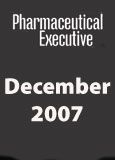
FDA Grants Priority Review to Regeneron’s Eylea for Macular Edema Following Retinal Vein Occlusion
April 18th 2025Regulatory action was based on data from the Phase III QUASAR trial, which demonstrated that Eylea HD dosed every eight weeks achieved non-inferior visual acuity outcomes compared to Eylea in patients with macular edema following retinal vein occlusion.
Addressing Disparities in Psoriasis Trials: Takeda's Strategies for Inclusivity in Clinical Research
April 14th 2025LaShell Robinson, Head of Global Feasibility and Trial Equity at Takeda, speaks about the company's strategies to engage patients in underrepresented populations in its phase III psoriasis trials.
New Insights Into T Cell Exhaustion and Inflammation in Long COVID
April 17th 2025Nigel McCracken, chief operating officer, Virax Biolabs, discusses new findings that reveal altered cytokine activity and evidence of T cell exhaustion in long COVID patients, providing deeper insight into post-infection immune disruption.
Key Findings of the NIAGARA and HIMALAYA Trials
November 8th 2024In this episode of the Pharmaceutical Executive podcast, Shubh Goel, head of immuno-oncology, gastrointestinal tumors, US oncology business unit, AstraZeneca, discusses the findings of the NIAGARA trial in bladder cancer and the significance of the five-year overall survival data from the HIMALAYA trial, particularly the long-term efficacy of the STRIDE regimen for unresectable liver cancer.
Amgen’s Imdelltra Demonstrates Significant Overall Survival Improvement in Small Cell Lung Cancer
April 16th 2025In the Phase III DeLLphi-304 trial, patients with small cell lung cancer administered Imdelltra achieved a statistically significant and clinically meaningful improvement in overall survival compared to standard-of-care chemotherapy.